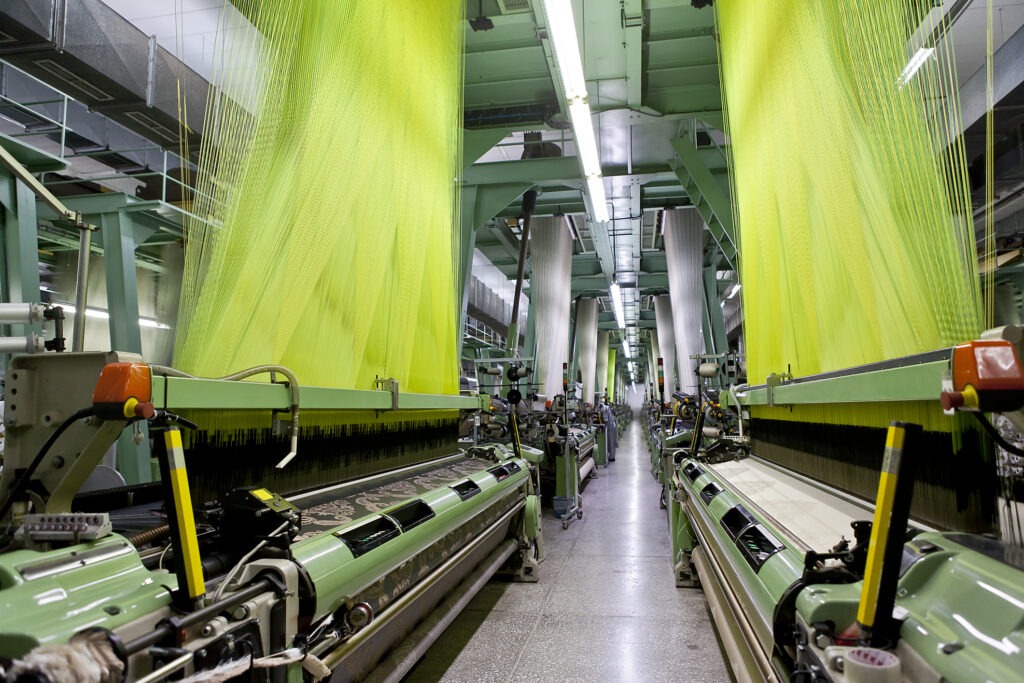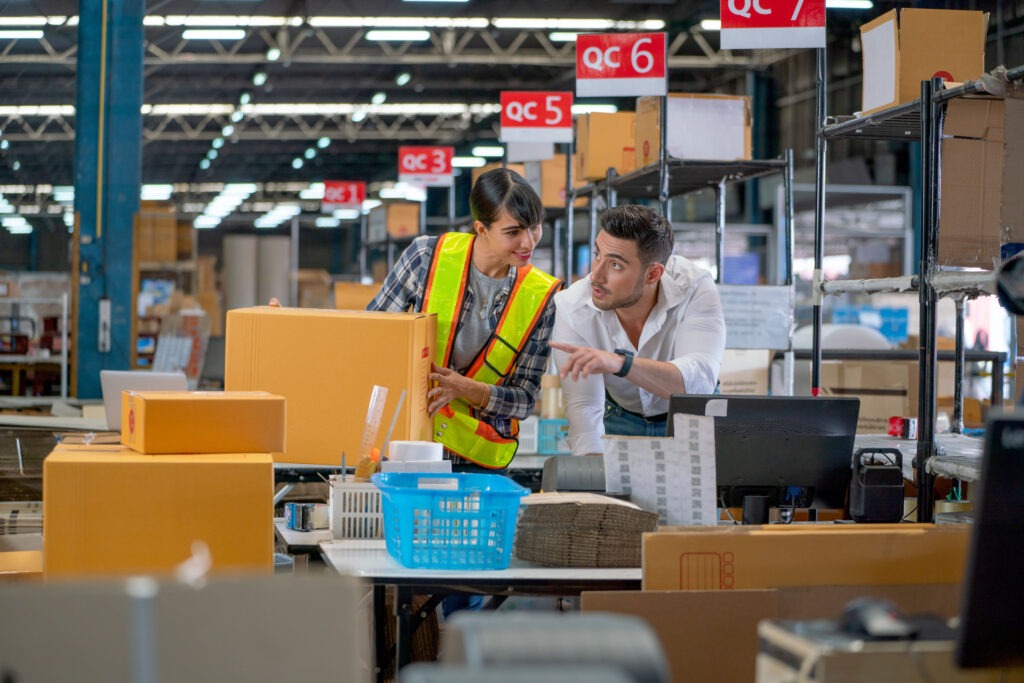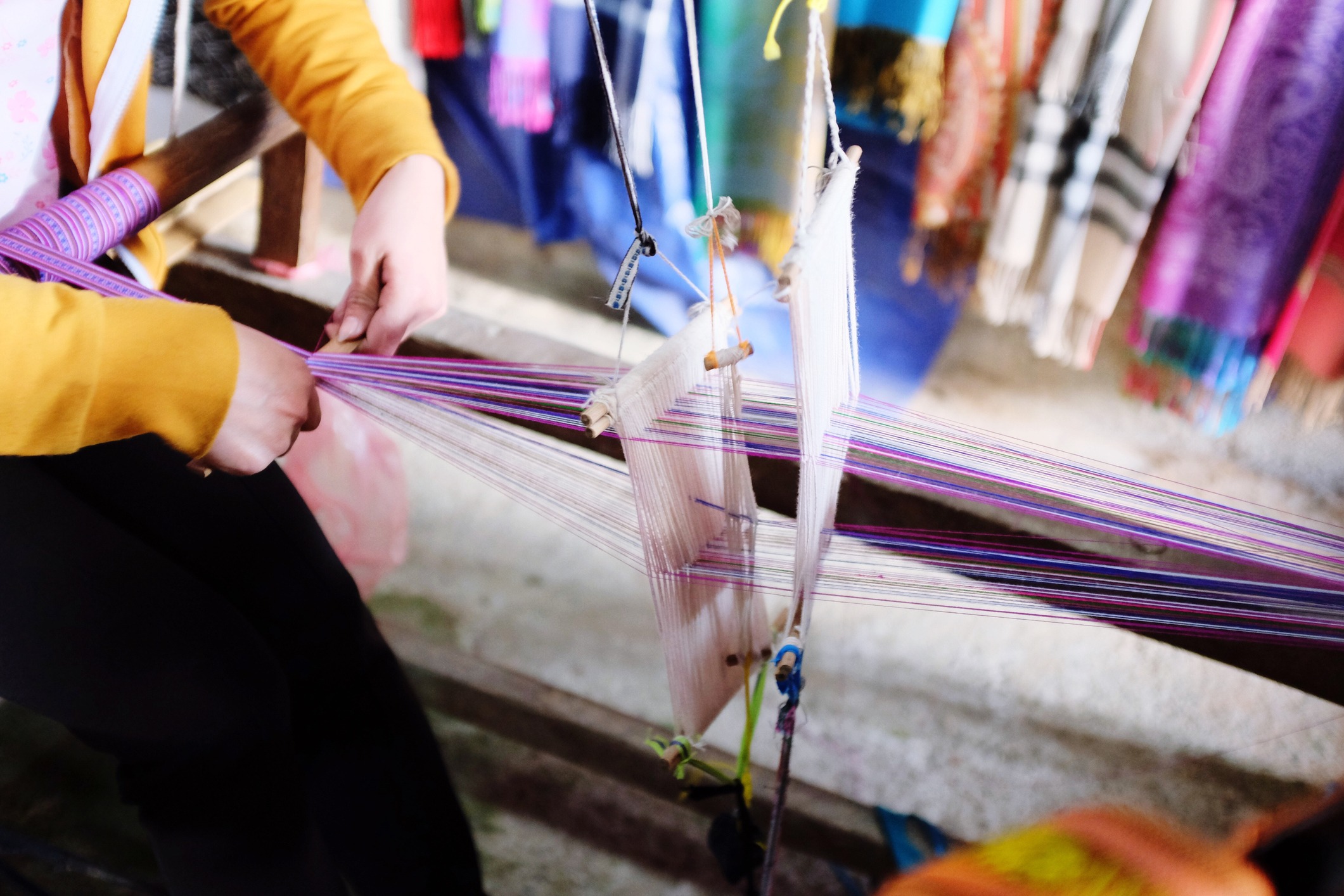What tasks do production employees perform in the textile industry?
- What tasks do production employees perform in the textile industry?
- How is the deployment of production employees structured within the textile industry?
- Which professions are there for production employees in the textile industry?
- What are the working conditions and what does a production employee in the textile industry earn?
- How do production employees work in fabric testing?
- What activities do production employees perform when dyeing and bleaching textiles?
- What health risks exist when dyeing and bleaching in the textile industry?
- What tasks await production employees in packaging, transport and quality assurance within the textile industry?
Estimated reading time: 23 minutes
The textile industry is concerned with the production of textile materials and their processing. The value chain ranges from the preparation of fibres to the production of finished clothing, technical textiles, and home textiles. Fibre preparation, in turn, deals with preparing natural fibres and man-made fibres in such a way that they can be used in the production of textiles. Natural fibres come from wool, silk, and cotton.
In the next step, yarns and twisted yarns are produced from the prepared fibres. This is also referred to as fibre processing. This is followed by yarn processing. Here, weaving, knitting, felting, and warp knitting take place. The goal is to produce textile surfaces from the yarns and twisted yarns.
This is followed by textile finishing. Here, the textile surfaces are taken and treated so that they receive the special properties and appearance they need for the intended use of the end product. This includes printing or dyeing them. They also receive additional properties here, including being antibacterial or water-repellent.
In the next step, the actual end products are manufactured. This means that textile manufacturers convert finished textile surfaces into end products. These can be personal clothing for sport, leisure, going out, or work. Home textiles are also included. These include carpets and curtains. Finally, this step also includes technical textiles, such as the upholstery of car seats in the automotive industry.
In this way, the textile industry takes on an important role for itself by contributing several steps to the production of important textiles and clothing. But it is also an important supplier on which other sectors of the economy, such as the automotive industry, depend.
How is the deployment of production employees structured within the textile industry?
Production employees are needed in the textile industry for a range of different tasks. While a large part of the production is carried out by machines, it is the people who take over important supporting tasks, additional work steps, and the handling of the machines. This means that the tasks of production employees can vary greatly in detail and begin with the cutting of materials for use in the machines. They then continue with operating the machines and reach their peak with sewing, quality assurance, as well as packaging and shipping.
- The cutting of materials involves production employees working according to a pattern. This allows them to cut the fabric of the textiles and other materials in a way that machines can hardly manage.
- They also carry out assembly work. Of course, this does not involve assembling machines or connecting components. Instead, garments and textile products are joined together to create certain patterns and shapes. For this reason, the step is not referred to as assembly, but as sewing work.
- Naturally production employees also operate the machines in the textile industry.. These are sewing machines, cutting machines and other equipment used for textile processing and production. The machines have to be loaded, adjusted, monitored, maintained and cleaned. The materials required for loading the machines are also prepared as needed. This means that they have to be sorted, rolled up and clamped into the machines.
As part of textile finishing, there are also tasks waiting for the production employees. They take care of dyeing and printing. This means they work with chemicals and machines that introduce these chemicals into the clothing. Specific safety regulations apply here, which must be observed. Production employees are also responsible for the machines used in this area, including cleaning and basic maintenance work.
Naturally, there is also ongoing quality assurance in this area. Materials, processes, and products are checked to ensure they meet various requirements.
There is also the area of packaging and shipping. Here, production employees are responsible for preparing the products for shipment, stocking the warehouse, transporting the products, packing them, and labelling them.
Which professions are there for production employees in the textile industry?
Within the textile industry, there are professions that are similar to those in other sectors, but also specific professions that focus on the production of textiles. This begins with the production employee himself. This designation includes all areas in which people are active within the industry, and this also applies to the textile industry.
Machine operators can also be found in the textile industry. As the name suggests, they specialize in operating machines. In the context of the textile industry, these are of course machines used for the production of textiles. The operators are responsible for ensuring that the machines work correctly. This includes adjusting and monitoring them. They readjust them if necessary, identify malfunctions and eliminate them. They also clean the machines after use or whenever it is necessary during operation.
A quality inspector, in turn, is responsible in the textile industry for ensuring the quality of the products. For this purpose, they analyze the materials upon delivery and the products before shipping. They review the processes and make suggestions for optimization.
Then there is the profession of skilled practitioner. This person specializes in specific tasks, for example sewing and tailoring. With the necessary experience, they can efficiently produce large quantities with good quality.
There are also laboratories in the textile industry. Accordingly, there are also textile laboratory technicians. They are responsible for examining and analyzing textiles and other materials. In doing so, they support quality assurance, and they are also responsible for identifying the right fabrics with the right properties at the lowest possible cost.
Then there is the profession that so many people wish for, namely that of the fashion designer. This person is responsible for developing new textile models and creating new designs. In doing so, they create or follow trends and ensure the company's success by constantly providing new products that are enthusiastically received by customers.

What are the working conditions and what does a production employee in the textile industry earn?
The working conditions in the textile industry depend on various factors. These include the location of the company, the company itself, and the products that are manufactured. However, it is still a reality that the working conditions generally place high demands on the individual.
The work involves long periods of standing. Certain work steps must be carried out with high precision. At times, heavy loads have to be moved. This is associated with long working hours. Also, many employees are traditionally women, meaning they are particularly burdened in this area. In addition, at least parts of the work also take place in loud and sometimes quite dusty areas. There are also odors caused by dyes and other chemicals.
The salary paid for this is not always among the best. It also depends on various factors, with the company and its location again playing a major role. Entry-level salaries range around 2,000 euros gross per month. With a little professional experience, they can then rise to 2,700 to 3,000 euros gross.
What tasks do the production employees fulfil when sewing and processing the textiles?
In the textile industry, an important step is processing fibres in such a way that yarns and twisted yarns are created, which are then used to produce the actual textiles. This means that weaving, gluing, knitting, and sewing take place here. In doing so, the individual parts of the textiles are assembled so that the desired product is created in the end. Two things are particularly important: the seams and the precision. The seams must be of such good quality that the textiles withstand the stresses of everyday life. They must be sewn so precisely that, in the end, exactly the shape and size desired are achieved.
The sewing work and the processing of the textiles are done by hand and by machine. The processing of cotton, wool, nylon, and polyester is usually a process in which systems play a major role. Machines are also used for weaving, gluing, and knitting. However, many steps can only be carried out by hand, for which the production employees must proceed with the necessary care.
In fabric processing, machines are also used extensively. Here, fabrics are bleached, washed, dyed, and printed. In most cases, this can not only be done more easily and efficiently by machine, but it is also often a matter of health. While the chemicals in clothing are harmless on the skin, in large quantities, such as in a bath for dyeing, they can become a burden that, over time, may have effects on the skin and health. Machines help to prevent excessive contact with the chemicals.
Sewing and assembling different fabric pieces can, depending on the type and shape of the seam, be done by machine or must be done by hand. Long seams for technical textiles or simple seams for clothing can be sewn by machine. Other, smaller seams that are not straight, however, require manual work.
The seams and their quality are crucial for the product’s lifespan and its appearance. To ensure they are stable and look good, there are certain machines and techniques that help. For example, double seams increase the durability of a product.
How do production employees work in fabric testing?
Fabric testing plays an important role in the textile industry. It involves complying with safety standards, avoiding harmful chemicals, and meeting the customers' quality requirements.
To meet these objectives, fabric testing consists of various tests. These check the physical, chemical, and mechanical properties. In the process, the fibres are identified, their properties such as tensile strength and abrasion are determined, and the exposure to chemicals is checked.
The analysis of the fibres, in turn, takes place in both qualitative and quantitative terms. For the qualitative analysis, it depends on which substances the fibres are made of. Microscopes are used for this, and chemical tests are carried out. It is also possible to determine what is in the fibres by burning them and analysing the residues. In the quantitative fibre analysis, the employees determine how high the proportion of the individual fibre types is in the fabric.
In the physical testing, it is determined how well the textiles can withstand environmental influences. This begins with the tensile strength. Here it is checked what maximum force the fabrics can withstand without tearing.
It is also tested how well the fabrics can withstand abrasion. In the spray test, in turn, it is checked how water-repellent the fabric is. That is, how quickly or how easily water can penetrate or pass through the fabric, and how much water is absorbed by the fibres.
In the washing test, the aim is to determine how stable the fabric is. Does it shrink during washing? Does it crease or disintegrate over time? And then there is the test for flammability. Here it is important to determine how fire-safe a fabric is. Especially with regard to fire safety and the regulations aimed at it, this test is very important.
How does the mechanical and chemical testing of materials work?
In the mechanical testing, it is once again about tensile strength, but here also in relation to the fibre direction. Tear resistance is also determined. In addition, a test is carried out for shock loads.
The chemical testing deals with determining which substances are present in the fabric. It is primarily about harmful substances such as heavy metals, formaldehyde, AZO dyes, and more, also with regard to the environment as a whole, this is important. Even in smaller doses, these can have harmful effects over the wearing period of textiles. Compliance with certain eco-textile standards is also checked here.
Further tests refer to the appearance and colour. The question is whether the products have the optical properties, shapes, and colours that were ordered. Colour fastness is also checked. For this, the products are first washed, and then it is checked how they look after the washing process.
This is accompanied by the testing of dimensional stability. That means it is checked whether the fabrics stretch, whether they shrink, or whether they become wrinkled through washing. It is also checked whether small nodules form in the fabric during washing processes.
What is the purpose of fabric testing?
Fabric testing serves three overall purposes: ensuring quality, guaranteeing safety, and complying with legal requirements. For quality assurance, there are specific requirements formulated by the client. It must be ensured that the products also meet these requirements, thereby satisfying customers and leading to follow-up orders.
As part of safety testing, the main goal is to avoid textiles being contaminated with harmful substances. This applies both to the safety of the users and to the legal protection of the producer. If the company delivers textiles that lead to health damage, significant claims for damages can quickly arise.
Finally, there are legal requirements and regulations regarding textiles. These must also be complied with. The regulations differ significantly depending on the intended use. Textiles intended, for example, for the production of children's and baby clothing are subject to different requirements than textiles for technical use.
What activities do production employees perform when dyeing and bleaching textiles?
Dyeing and bleaching are two very important work steps in the processing of textiles. However, these are often viewed with a little unease. Due to the chemicals used, there are various health risks for the production employees during this work, so they must carry it out with sufficient care.
When dyeing and bleaching, colours are introduced into the fabrics and these are given the desired properties. Bleaching precedes dyeing. In this process, the employees remove natural impurities and prepare the fabric for the subsequent dyeing. This then consists of applying dyes into the fibres so that they settle there and visually change the fabrics.
Bleaching is very important, because naturally present impurities can prevent or impair the absorption of the colours by the fabric. As a result, there may be a lack of colour intensity or uneven colour absorption, which leads to an unclean appearance. Therefore, for colour brilliance and uniformity, it is important to first remove the impurities through bleaching.
For bleaching, the production employees use various chemical compounds or bleaching agents. These include acids as well as alkalis, or chlorine and hydrogen peroxide.
The substances are often toxic and also carcinogenic. Therefore, it is important for the employees, but also for the environment as a whole, to proceed with caution and responsibility.
In the subsequent dyeing, the desired colour is applied to the fabrics. This can take place in dye baths or the colours are simply printed on. The colours can also pollute the environment. In addition, a lot of water is used, which itself poses a burden and leads to toxic wastewater. Therefore, careful working is also required here.
As part of responsible working, it is also important that the textile industry increasingly focuses on sustainability. It is known as a major water consumer and pollutes the environment with the chemicals that enter the wastewater. Therefore, production employees are constantly encouraged to use water and chemicals sparingly wherever possible. They should also immediately bring forward any suggestions for improvement so that the use of water and chemicals can be further reduced.

What health risks exist when dyeing and bleaching in the textile industry?
- There is clearly a health hazard for the production employees who work in the area of dyeing and bleaching. This begins with respiratory diseases, continues with skin allergies and reaches its peak with a real cancer risk. The dangers come from the chemicals and substances that employees use in the processes. Therefore, it is important to use sufficient personal protective equipment and to generally avoid contact.
- The dyes that colour the textiles often release aromatic amines. These lead, with prolonged contact, to skin allergies and the occurrence of dermatitis. Chlorine bleach, in turn, can also cause problems through the air and lead to asthma and breathing difficulties.
- Certain dye pigments contain heavy metals. These include mercury, chromium, lead, cadmium and copper. These too can, with long-term exposure built up over years of work, lead to health damage.
- Handling certain raw materials, a good example being cotton, leads to high dust exposure. This, in turn, can cause various respiratory diseases, including asthma, bronchitis, byssinosis and more.
The various exposures can also lead to further complaints. This is seen, for example in an impairment of the nervous system. There may also be limitations in fertility.
What is being done to reduce the exposure and thus the health risks?
Of course, companies are taking various measures to reduce the exposure and thus the risk to health:
- This starts with personal protective clothing. In some areas, work is only permitted with gloves and respiratory masks.
- In addition, contact with chemicals is reduced. Anyone who does not need to work in the area where they are located is not granted access. Good ventilation is also ensured in the halls to remove the hazardous substances from the air as quickly as possible.
- Employees often undergo regular medical examinations. This allows early detection of any health effects, and countermeasures can be taken.
- Training sessions also take place. In these, production employees are informed about existing health risks. They are also instructed on how to protect themselves. This includes training on the use of protective equipment along with guidance on why proper use is so important.
There are certifications and standards for the textile industry. These are also intended to protect the health of production employees. It is therefore important that employees know the standards, comply with them themselves, and ensure that other employees and the company meet these standards as well.
What tasks await production employees in packaging, transport and quality assurance within the textile industry?
Other areas that are also of great importance in the textile industry are the work steps of packaging, transport and quality assurance. These ensure that the products reach the customers as ordered and in the correct quality.
Quality assurance is intended to ensure the quality of the finished products. Packaging protects the goods on their way to the customer and also provides the basis for a good appearance and correct labelling. Transport ensures that shipping is safe and efficient. All this requires correct procedures by the responsible production employees.
Packaging uses various materials. These must be suitable for transporting textiles. That means it’s not always about protection from shocks or impacts. The priority is to protect the textiles from dust and moisture. Depending on the textiles, employees pack them either hanging or lying flat.
In addition to the labelling and the protection of the enclosed textiles, the packaging must also fulfil a few more tasks depending on the order and the situation. This includes, for example, attaching security tags. These must be easy for authorised personnel to attach and remove. They serve as theft protection, so employees attach them in such a way that unauthorised persons cannot easily spot or remove them.
Furthermore, the call for sustainability has also reached the packaging sector. Therefore, production employees must also choose the right materials for packaging from an environmental perspective. This includes, for example, using recycled materials.

What tasks do production employees perform in transport and shipping?
The production employees responsible for shipping choose the best mode of transport. This can be a simple flat shipment, for example, or require special packaging that protects sensitive textiles.
Furthermore, the production employees in transport optimise the route for shipping. This helps to avoid or at least minimise transport damage from the outset. They also handle the documentation for shipping and set up tracking options.
Quality assurance takes place throughout all stages of production and pursues several objectives. Firstly, it is about avoiding errors. Two aspects are important here: No defective goods must reach the customer, this would affect customer satisfaction and put follow-up orders at risk. At the same time, the production employees must reduce waste, which itself incurs costs.
Secondly, it is important to maintain quality in such a way that it meets the customer’s specifications. Here too, the focus is on customer satisfaction, the company’s good reputation, and securing future orders. Ultimately, the textiles themselves should be safe and durable.
What are the objectives of quality assurance?
In addition to these main objectives, there is another area that falls under the goals of quality assurance. This involves sustainability. The employees in quality assurance also monitor the processes that take place in production. They make suggestions for improvement that also take the environment into account. This includes reducing costs through less waste and a more economical use of consumables, such as dye and bleach. It also includes a reduction in emissions, for example through greater energy efficiency. They also promote the use of recycling and the achievement of a circular economy.
To achieve these goals, the quality assurance employees apply several tests. This begins with checking the fabrics during production or delivery, depending on the company. They also ensure the correct cutting, the right seam quality, and the finishing. Even the packaging at the end is checked to ensure that the goods are protected as intended on their way to the customer.
The inspections focus on various properties. These include the quality of the raw materials, compliance with the design specifications regarding dimensions, stable and firm seams, good colour consistency, and sufficient tear resistance.
Conclusion
In the textile industry, various areas of application are available to employees. This starts with auxiliary tasks, continues with operating the machines, and extends to sewing, packaging and shipping, as well as quality control.
The working conditions for production employees are quite demanding. They involve standing for hours, lifting loads, and working with various chemicals that are not without danger. However, remuneration in the textile industry is rather low compared to other sectors.
The employees are responsible for sewing parts, bleaching the fabrics, dyeing them, and finishing them. They also test the fabrics to see whether they meet the requirements. This includes testing strength, colour quality, and the substances contained in the fabrics.
In the course of their work, employees are exposed to health risks from the chemicals used. Therefore, they often have to wear protective equipment. They are also trained on the hazards, and measures are taken to reduce the risks. This is done, for example, through strong ventilation so that toxic substances are quickly removed from the air.
Production employees also work in the areas of packaging, transport, and quality assurance. The packaging must primarily protect the textiles from dust and moisture. Transport must ensure the safe and efficient shipment to the customer. Quality assurance must ensure the quality of the delivered materials, the processes, and the packaged end product across the board.
Related topics:



